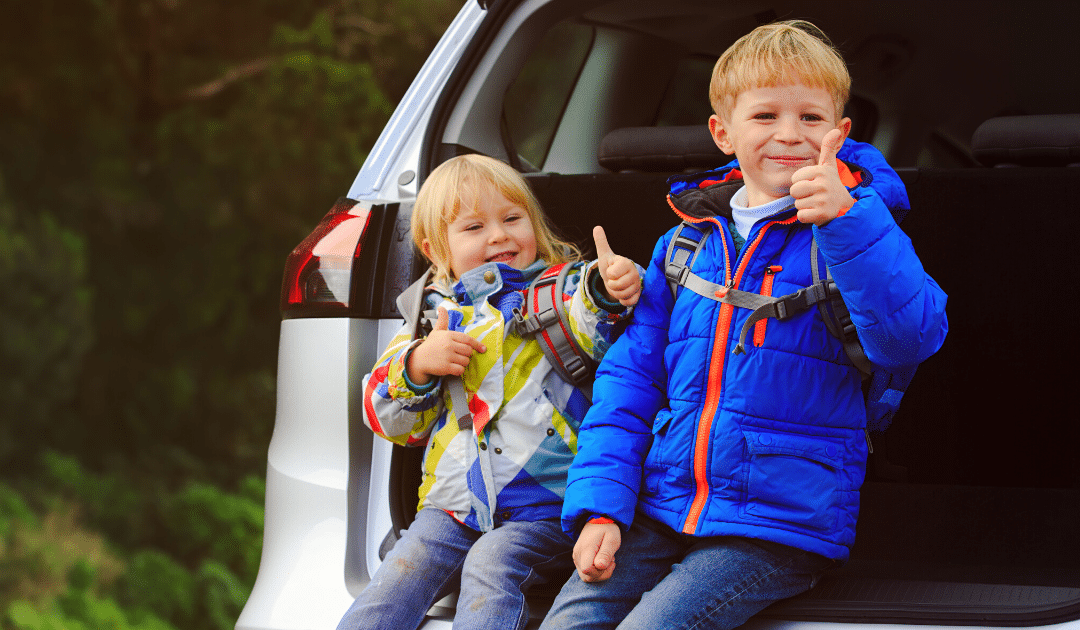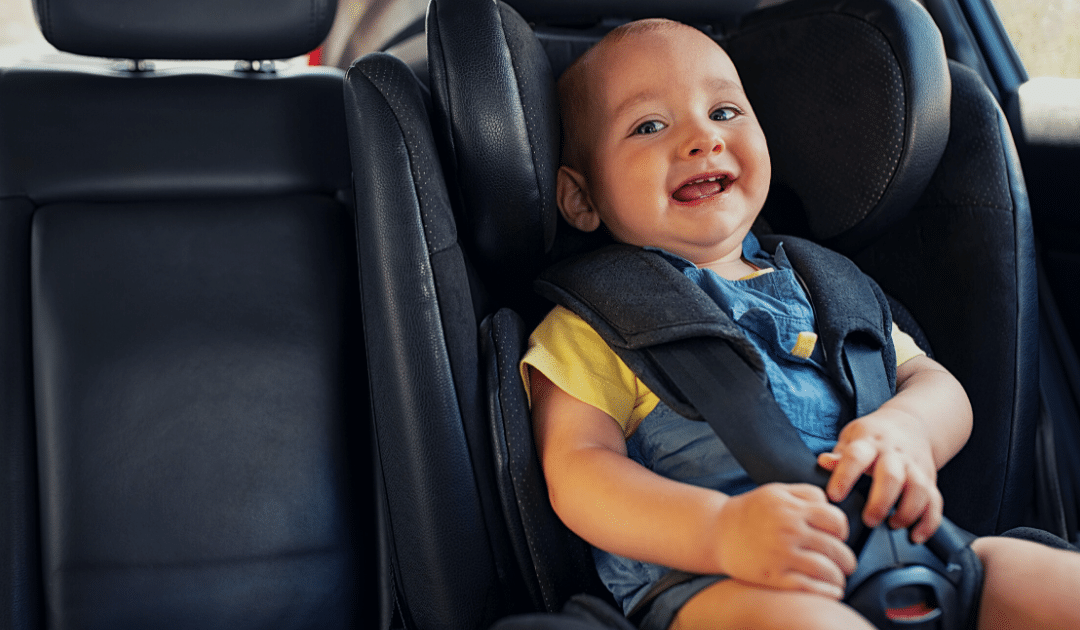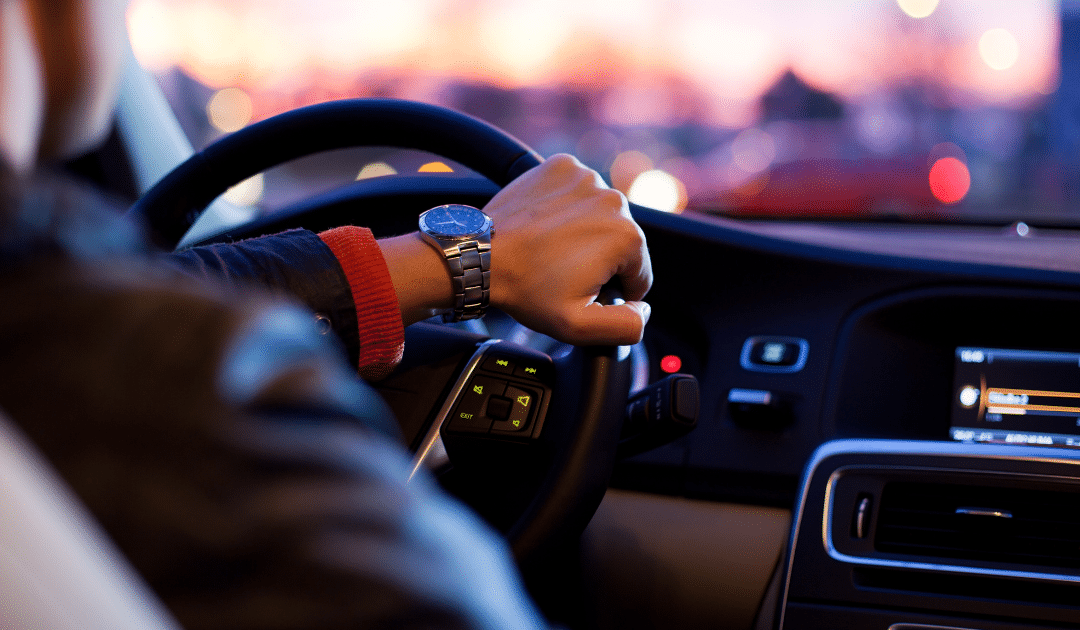
by California Casualty | Auto Insurance Info, Travel |
Traveling with a toddler is always an adventure — no matter where you go!
In observance of Child Passenger Safety Week, we’ve compiled a safety checklist for trips near and far. And because we care about your mental health (wink), we’ve also included some parental survival strategies for good measure.
Plan your getaway and go make some great road trip memories!
Safety First
- Make sure your car’s road-ready – A lot can happen out there, so be sure to get your car serviced ahead of time. Tires, oil, engine fluids, wipers — make sure they’re all in tip-top shape.
- Get a car seat inspection – If you have any doubts about whether your car seat’s installed properly, you can book an appointment with a Certified Child Passenger Safety Technician in your community by visiting here (use the search tool at the bottom). While you’re at it, register your seat online so you can get notified in case of a safety recall.
- Guard against heatstroke – Heatstroke can occur at any time of year, in any condition, and in any community. Protect your child by taking them with you instead of leaving them in the car alone and always looking in your car before locking. Keep your vehicle locked when not in use (and keys away from curious little hands).
- Eliminate back over risk – Tragically, many children are killed or injured by cars backing out of driveways and parking spaces. There are many precautions you can take as a driver and ways you can protect your children against a backover accident — see the National Highway Traffic Safety Administration’s list here.
- Don’t leave them alone in the car – Even if you need to run into the store for “just a minute” it’s better to be safe than sorry. From heat stroke to foul play to your child getting loose in the car, the risk of leaving them in the car far outweighs any savings in time or trouble.
- Make sure you have roadside assistance – Out of mind when you don’t need it, priceless when you do — roadside assistance is especially important when traveling with young ones. It usually covers towing to a service station, battery jumping, flat tire repairs, unlocking car doors, and a range of other catastrophe rescues.
- Pack your first aid kit – Bruises, scrapes, stings, sunburns, and splinters are just as likely to happen away from home. Be ready with your kit, and maybe even refresh your first aid and CPR skills.
- Prevent power window injuries – Keep little fingers, hands, and wrists safe by using the power window locks, making sure toddlers are secure in their car seats, and teach them not to play with the switches.
- Secure the seat belts – Keep your child from getting entangled in seat belts by securing the loose ones within their reach. Ensure they’re restrained in their car seat at all times while in the car.
Sanity-Savers for You
- Separate the kids – It’s inevitable: if you’re traveling with more than one kid, they’re going to fight at some point. Get ahead of the inevitable by seating them as far from each other as possible. Obviously, the bigger the car, the easier this is.
- Take breaks – Kids need to move. Heck, adults need to move! If you can look for parks or playgrounds, all the better — but any place that lets you stretch your legs, move around and break up the monotony will work.
- Prep your hygiene arsenal – Make sure to pack plenty of potty supplies, wipes, tissues, and paper towels (not to mention cleaning supplies for spills and food accidents).
- Kid-ify your itinerary – Plan your trip with your kid(s) in mind. This means taking nap schedules and energy peaks/valleys into account, and planning out when you’ll arrive at destinations (and what those are), when will be best for the multi-hour highway time, etc.
- Stock up on healthy snacks – Having nutritious snacks on hand prevents you from desperation-buying chips at the gas station or sitting through a sugar crash tantrum. Raw veggies, fruit, trail mix, crackers, and low-sugar baked goods are usually winners.
- Don’t forget the entertainment – Keeping toys and books close to your toddler will allow you to keep your eyes on the road and hands on the wheel. If your car has a screen, bring in-flight entertainment! Finally, playing road games is a favorite, no matter the generation.
- Bring binkies and blankies – It’s important to pack some comfort from home if you’ll be gone for any length of time. Blankies and binkies might calm your child like nothing else in the midst of the excitement and new surroundings.
Prepping ahead of time will make any road trip smoother, but it does wonders for traveling with toddlers.
This article is furnished by California Casualty, providing auto and home insurance to educators, law enforcement officers, firefighters, and nurses. Get a quote at 1.866.704.8614 or www.calcas.com.

by California Casualty | Auto Insurance Info, Safety |
Booster seats were designed for that critical time when a child has outgrown their car seat but isn’t yet tall or heavy enough to be safe in a seat belt alone.
Here’s a primer on the different booster types, tips for buying and installing one, and help on determining when it’s safe to transition your child out of the booster for good.
Booster Seat Types
There are 4 types of boosters, differentiated by your child’s needs and also your preferred functionality.
Backless Booster Seat – Boosts the child’s height so that the seat belt fits properly. Best for cars that have headrests.
Booster Seat with High Back – Like the first seat type, this raises the child’s height so as to ensure a proper seat belt fit, but it provides neck and head support.
Combination Seat – Accommodates a child’s growth by transitioning from a forward-facing seat with a harness into a booster.
All-in-One Seat – Like the combination seat, this one transitions as well, but goes from rear-facing seat, to forward-facing, and finally to a booster.
Whatever style you choose, make sure the seat has a guide for your car’s shoulder belt, so that it lies across their torso correctly. Also, make sure the guide allows the belt to retract easily. Some seats have clips, wings, and even adjustable bases, all of which further tailor to your child’s height/weight and the specifics of your vehicle.
Learn more about seat types at the National Highway Traffic Safety Administration’s (NHTSA) page.
Tips on Buying and Installing
Buying a booster seat
- Always buy new, as used seats may not fit your child correctly or could even be unsafe.
- If your child weighs less than 40 lbs, a combination seat may be your best bet.
- Avoid seats with a reclining feature as they can put your child at an increased risk of injury in an accident.
Installing the seat
- Like car seats, boosters should only be installed in the back seat.
- The safest spot is in the center of the rear seat — which best protects against side-impact crashes — but only if your vehicle has a lap and shoulder belt in the center. If there’s only a lap belt, put the seat on the passenger side so you can better see your child from the driver’s seat.
- If using a combination seat, use the anchoring system. This is called the LATCH system, short for Lower Anchors and Tethers for Children.
- Use the seat’s belt-positioning clips if it came with them. They ensure that the belt crosses your child’s chest correctly.
- Check out these videos by the NHTSA for instructions on properly installing high-back boosters, backless boosters, combination boosters, and all-in-one boosters.
A Checklist: When Can They Graduate Out of a Booster?
According to the NHTSA, more than 25% of kids aged 4 to 7 are transitioned out of a booster seat too soon. The organization recommends that children continue using a booster until they’re at least 4 feet 9 inches tall AND 8 to 12 years old. They should also have outgrown the seat manufacturer’s weight and height recommendations.
If you can answer “yes” to all of the below when your child is sitting on the vehicle seat, then they can move from a booster to seat belts only.
- Is their back flat against the seat back?
- Do their knees comfortably bend at the seat’s edge?
- Does the shoulder belt lie between their neck and shoulder?
- Does the lap belt lie against their hip bones/tops of thighs?
- Can they remain comfortable for the whole trip? (i.e. without fidgeting, sliding, or pushing the belt out of position)
We know that boosters can be a hassle and that you’re probably fielding the “Do I still have to use the booster seat?” question a few times a week — but hang in there! Graduating your child when they’re actually ready to leave the booster is much safer for your precious cargo — and may be closer than you think.
Booster seats? Check. Need tips on car seats? Check out our blog post here.
This article is furnished by California Casualty, providing auto and home insurance to educators, law enforcement officers, firefighters, and nurses. Get a quote at 1.866.704.8614 or www.calcas.com.

by California Casualty | Safety |
Power outages can last anywhere from a few hours to days or even weeks. In the latter case, an outage can affect entire communities, disrupting communications, transportation, and emergency response or health care services. It can also close businesses, banks, gas stations, grocery stores, and other services.
Understanding why and how they happen can help you better prepare. Next, having a plan and taking precautions ahead of time will help you and your family ride out the outage with less stress and a greater sense of control.
When and Why They Happen
Knowing how outages happen can sometimes help you predict when they’re most likely to occur – for instance, during storms or heatwaves. Other times, they’re random and unpredictable.
-
- Weather – Storms and weather events such as high winds, ice, and snow are the most common cause of outages, oftentimes due to trees and limbs taking down power lines. Rain and flooding can also damage above-ground or underground electrical equipment. And earthquakes of all sizes can damage electrical grids.
- Animals – Far and away, squirrels cause the most damage to power lines, but snakes and other critters can prompt an outage by nesting in or climbing on transformers, boxes and other equipment.
- Human Error – Car accidents and digging mishaps — when underground lines are hit — are a common cause. Additionally, electrical overuse during heatwaves and other times of unusually high demand can overburden cables, transformers and other links in the system.
Get Ahead of an Outage with Smart Planning
Planning and preparation are key to making a power outage manageable. There’s no better time than today to get started on the steps below.
Communications
-
- Download the NOAA radio app, your local weather alert app, and any other emergency app of your choice.
- Talk to your medical provider If anyone in your household requires electric medical devices or refrigerated medication. Get guidance on what to do if you lose power.
- Update your phone number and contact information with your electric provider.
Plans and kits
-
- Assemble or update your emergency kit – one for your family and another for your pet(s). Be sure to check and replace all batteries and have fresh back-ups. Also make sure you have COVID-19 supplies such as hand sanitizer, wipes, masks, and gloves.
- Make sure your household evacuation plan is current, and all household members and pets are accounted for.
- Know your local community’s risk and response plans.
- Have a plan, budget, and some extra cash on hand in case power restoration is delayed.
In Your Home
-
- Install surge protectors to help safeguard expensive appliances, computers and entertainment systems.
- Install carbon monoxide monitors with battery backup on every level of your home.
- Have at least a half tank of gas in your car at all times.
- Purchase household and food supplies ahead of time and stash some extras in case of an extended outage.
A Go-To Plan for When the Grid Goes Dark
Ideally, you and your family will have been able to take the above steps before the lights go out. If so, you’ll be ready to put the following strategies into place in order to remain as safe and comfortable as possible during the outage.
Communications
-
- Tune into the NOAA radio on a battery-powered or hand-crank radio, and/or the local radio station for news and weather updates.
- Report the outage immediately to your local power provider (have their info printed out and handy).
In Your Home
-
- Turn off and unplug all appliances, including the air conditioner, water heater, furnace, and water pump, as well as any sensitive electronics. Leave one light on to know when the power’s been restored – this helps prevent a circuit overload when everything comes back online.
- Keep refrigerator and freezer doors closed. Frozen food will stay frozen for 24-48 hours, depending on how full the freezer is. For refrigerated items, after about 4 hours, move perishable items into a cooler with ice (they should remain at 40 degrees Fahrenheit or colder to be safe).
- If using portable stoves or lanterns, only use them in sufficiently ventilated areas.
- Use flashlights instead of candles.
Outside
-
- Report any downed power lines to your electric company. Keep yourself, family, and pets away from downed lines, flooded areas, and debris.
- Avoid driving if you can. Traffic lights will be out and roads will be chaotic and unsafe.
- If you’re operating a generator, follow safety protocols. Never operate it in your home, garage, or other enclosed spaces.
- Check on your neighbors. The elderly and young children are especially susceptible to extreme temperatures.
The length of time it takes to restore power can vary according to the cause of the outage, the extent of damage, and the geographic area affected. Electric companies have detailed plans and procedures for restoration — starting with repairs to damaged power infrastructure, then re-powering critical community services, and finally restoring power to individuals and businesses in order of density.
By following the tips above, you can ride out the worst of it with less stress, knowing you prepared well.
This article is furnished by California Casualty, providing auto and home insurance to educators, law enforcement officers, firefighters, and nurses. Get a quote at 1.866.704.8614 or www.calcas.com.

by California Casualty | Auto Insurance Info |
Labor Day weekend marks the unofficial end of summer – celebrated across the country with boating trips, long camping weekends, and backyard grilling and pool parties. But it also marks one of the year’s deadliest times on the road.
If you and your family are planning to travel by car this holiday weekend, use these defensive driving techniques to stay safe out there.
7 Principles of Defensive Driving
1. Be aware of your surroundings – Avoid tunnel vision, making sure to keep track of any pedestrians, bicycles, motorcycles, or cars around you. Maintain an awareness of the road in front and behind, as you’re susceptible to the ripple effects of traffic events such as rear-endings, collisions, and other unexpected road emergencies. Also, stay alert to the weather — rainy, snowy, icy, foggy, and windy conditions can change from minute to minute.
2. Anticipate bad moves by other drivers – Assume other drivers are going to do the wrong thing. For example: turning without signaling, changing lanes into a blind spot, or crossing multiple lanes to make the off-ramp. Most of the time, they won’t make the dangerous move, but if they do, you’ll be prepared.
3. Avoid distractions – Distracted driving comes in 3 flavors: visual, manual, and cognitive. The first takes your eyes off the road; the second, your hands off the wheel; and the third, your mind off the road. Cellphones, passengers, snacking, daydreaming and GPS controls are common culprits. Before you set off on the road, make sure your phone’s tucked away, food’s already eaten, and kids are strapped in and occupied. Stay focused on the road while driving and remember you can always pull over if you need to.
4. Leave yourself an out – Especially on busy highways, try not to get boxed in by cars on all sides. Always leave yourself an out in case you need to move to safety quickly. For instance, if your tire blows, a deer jumps out in front of you, you encounter debris on the road or the car in front of you collides with another, you may have to change lanes, pull over or reduce speed – fast.
5. Be seen – One of the most dangerous places on the road is in another driver’s blind spot. Always position yourself where you can be seen. Use your headlights from 30 minutes after sunset until 30 minutes before sunrise, and when posted signs require them. Also know that if your car’s color doesn’t stand out, other drivers may not see you easily. Position yourself strategically and remember you can always use your horn as a last defense.
6. Follow the laws – Control your speed and follow all traffic laws. Knowing right-of-way rules will keep you safer at every intersection. Maintain safe distances from other vehicles and don’t tailgate. Finally, make sure you and your passengers wear seat belts at all times. By following the rules of the road, you can proactively reduce the chances of getting into an accident.
7. Expect the unexpected – In the spirit of principle #2, remember that anything can happen at any time on the road. And when it comes to car accidents, it’s often the unexpected that’s the catalyst for a crash. For this reason, the best offense is defense — and solid defensive driving skills.
You can’t control road conditions, weather, or random chance, but you can control how you react to all of them. Make safety a matter of habit, and always respect other drivers and the law.
Finally, consider defensive driving courses – either for you or your young driver. No matter the driver’s experience level, these courses are designed to help drivers anticipate situations and make safe, well-informed decisions.
This article is furnished by California Casualty, providing auto and home insurance to educators, law enforcement officers, firefighters, and nurses. Get a quote at 1.866.704.8614 or www.calcas.com.

by California Casualty | Auto Insurance Info, Homeowners Insurance Info |
If you’re like most boat owners, you probably only use your boat a few months out of the year. And after all those summer trips are done, and your boat’s cleaned up and ready for storage, you might be tempted to cancel the insurance.
After all, if your boat won’t even be on the water, why would you need coverage?
Turns out, there are some compelling reasons to keep your insurance throughout the year, not the least of which is that it can actually save you money in the long run. Here are 4 top reasons.
1. Accidents Don’t Have an Offseason
More than half of the claims are filed for accidents that occur between September and January. The majority of those are for theft, vandalism, fire, and flooding. Boats are typically unattended during this time, which increases accident risk. When you carry boat insurance, these claims are covered by comprehensive coverage, costing far less than out-of-pocket payments would for repair and replacement in the event of an insurance lapse.
2. It May Be Required
If your boat is financed by a lender, you may be obligated to carry insurance year-round. Even if you own your boat outright, some marinas may require boats on the premises to be insured.
3. Don’t Count on Your Homeowner’s Policy
Many boat owners assume that damage to their boat is covered under their homeowner’s policy. Most times this isn’t the case, as the boat would probably only be protected if damage occurred while on the covered property. And even then, a homeowner’s policy might not fully cover the damage and/or leave the owner with coverage gaps (for example, many homeowners policies have length and horsepower limits that apply to boats). Boat insurance policies are crafted to meet specific needs and protect against risks inherent to boating.
4. It Makes Financial Sense
Depending on your insurer, signing up for a full 12-month policy can make you eligible for discounts or loyalty benefits, saving you money over the long term. Also keep in mind that many insurers already adjust the off-season monthly premiums to be lower than the on-season ones, so an annual policy, in the end, does offer better protection dollar for dollar than one for just several months. And don’t forget that as your boat ages you may find it more difficult to secure insurance if you cancel your policy. Finally, if you insure your boat with the same company as your car or homeowner’s insurance, you can most likely get a multiple policy discount.
Just as with homeowners and car insurance, a policy protecting your boat against damage and liability not only provides peace of mind but is a wise financial decision. And given the risks specific to boats, choosing a year-round policy is even smarter.
This article is furnished by California Casualty, providing auto and home insurance to educators, law enforcement officers, firefighters, and nurses. Get a quote at 1.866.704.8614 or www.calcas.com.





